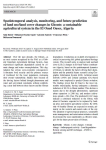Daich S., Saadi M.Y., Santoro A., Piras F., Boumaraf B. (2025). Spatiotemporal analysis, monitoring, and future prediction of land use/land cover changes in Ghouts: a sustainable agricultural system in the El Oued Oases, Algeria. Environmental Monitoring and Assessment, 01/09/2025, vol. 197, n. 9, p. 1062.
https://doi.org/10.1007/s10661-025-14488-3
https://doi.org/10.1007/s10661-025-14488-3
| Titre : | Spatiotemporal analysis, monitoring, and future prediction of land use/land cover changes in Ghouts: a sustainable agricultural system in the El Oued Oases, Algeria (2025) |
| Auteurs : | S. Daich ; M.Y. Saadi ; A. Santoro ; F. Piras ; B. Boumaraf |
| Type de document : | Article |
| Dans : | Environmental Monitoring and Assessment (vol. 197, n. 9, September 2025) |
| Article en page(s) : | p. 1062 |
| Langues : | Anglais |
| Langues du résumé : | Anglais |
| Catégories : |
Catégories principales 06 - AGRICULTURE. FORÊTS. PÊCHES ; 6.1 - Généralités. Situation AgricoleThésaurus IAMM SITUATION AGRICOLE ; OASIS ; SYSTEME DE PRODUCTION ; CHANGEMENT CLIMATIQUE ; SECURITE ALIMENTAIRE ; ALGERIE |
| Résumé : | Over the past decades, the Ghouts-as an oasis system recognized by the FAO as a Globally Important Agricultural Heritage System-have experienced significant degradation caused by climate change and water overexploitation. This degradation has serious socio-economic consequences: it threatens food security and the primary sources of livelihood for the local population, increasing their overall vulnerability. Studies have focused on the driving factors behind drought phenomena and water and soil-related constraints without establishing a clear link between these factors and the Ghouts degradation. Conducting an in-depth investigation is crucial to preserving this global agricultural heritage system. This research aims to analyze land use/land cover (LULC) changes in El Oued Valley (southeastern Algeria), based on the spatiotemporal dynamics of Ghouts, to identify the factors driving their degradation and the potential future scenarios using Geographic Information System (GIS). Artificial neural network (ANN) and cellular automata (CA)-based models were employed to predict Ghouts evolution. The findings reveal that El Oued is the most vulnerable municipality, having undergone a dramatic reduction of 89.3% in Ghout number. This decline is mainly due to the drought phenomenon, significant urban expansion (+ 2300 ha), and modern cultivations spread (+ 304.2 ha). The predicted LULC maps indicate a continued reduction in the Ghout, with about 62 hectares expected to be replaced by built-up areas and modern agricultural systems. By 2050, only 48 healthy Ghouts are expected to remain, primarily on the western and eastern sides of the city. The adoption of agroecological practices, sustainable water management, and valorization initiatives should be promoted by local stakeholders as effective strategies for the future preservation of Ghouts. |
| Cote : | Réservé lecteur CIHEAM |
| URL / DOI : | https://doi.org/10.1007/s10661-025-14488-3 |







